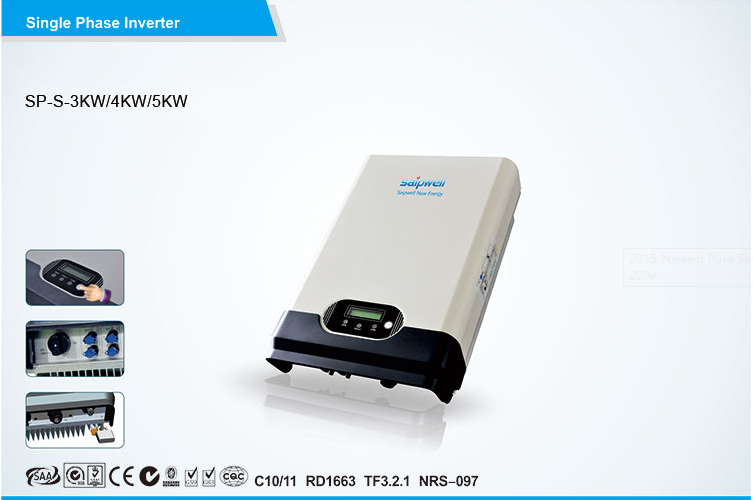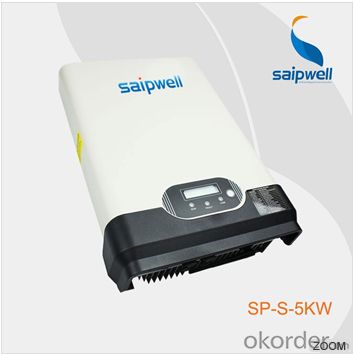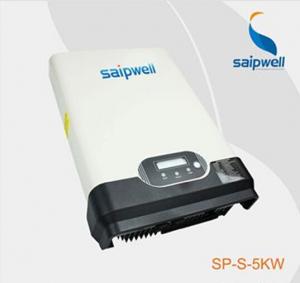Solar Inverter 5kw 220v 2015 Newest Pure Sine Wave
- Loading Port:
- China main port
- Payment Terms:
- TT or LC
- Min Order Qty:
- 5000 watt
- Supply Capability:
- 3000000 watt/month
OKorder Service Pledge
OKorder Financial Service
You Might Also Like
1. Structure of Solar Inverter 5kw 220v 2015 Newest Pure Sine Wave Description
The inverter series is an electronic product that has been designed and built to take low DC woltage power from batteries and convert it to
standard AC power like the current you have at home.
The Inverter series is a DC-to-AC with auto line-to-battery transfer and intergrated charging system. Inverter series powers from ACpower
and DC source, serving as an extended run UPS. When AC cable is connected to a wall socket, utility power goes to connected equipment
and/or charges the battery set via charging system. In Inverter mode, the Inverter series automatically converts battery energy into AC power
for backing up the connected devices
2. Main Features of Solar Inverter 5kw 220v 2015 Newest Pure Sine Wave
• Transformerless design, high efficiency (Max. 97.5%, Euro. 96.6%)
• High MPPT accuracy( >99.9%)
• Wide DC input range(120-590 Vdc), compatible with different module technologies
• Easy to wire, install and operate
• IP 65 design, suitable for indoor and outdoor installation
• 5 years warranty(10~25 years as option)
• Multi MPPT channels
3. Solar Inverter 5kw 220v 2015 Newest Pure Sine Wave Images


4. Solar Inverter 5kw 220v 2015 Newest Pure Sine Wave Specification
窗体顶端 Model窗体底端 | SP-S-3kw | SP-S-4kw | SP-S-5kw |
Input (DC) | |||
Max. DC voltage [V] | 590 | ||
MPPT DC voltage Range [V] | 120-500 | ||
Turn off DC voltage [V] | 120 | ||
Number of MPP Trackers | 2 | ||
Max. DC Current(A/B)[A] | 18/18 | ||
DC-Connection | MC4 | ||
Output (AC) | |||
Max. AC Power [W] | 3300 | 4400 | 4800 |
Nominal AC Power [W] | 3000 | 4000 | 4600 |
Max. AC Current [A] | 14.4 | 19 | 21.0 |
Nominal AC Current [A] | 13 | 17.4 | 20 |
Grid voltage Range | According to VDE 0126-1-1, RD1663, ENEL2010,C10/11,G83/1, AS4777 | ||
Grid Frequency Range | According to VDE 0126-1-1, RD1663, ENEL2010,C10/11,G83/1, AS4777 | ||
Power Factor | 0.99 (>30% of Full Load) | ||
THD(AC Output Current ) | <2% | ||
AC Connector | Plug-in connector | ||
Power Consumption | |||
Own Consumption in Operation [W] | 45 | 50 | 50 |
Power Consumption at Night [W] | 0 | ||
Power Consumption at Standby [W] | 6 | ||
Efficiency | |||
Max. Efficiency (at 360VDC) | 97.5% | 97.6% | 97.6% |
Euro. Efficiency (at 360VDC) | 96.6% | 97.0% | 97.0% |
MPPT Efficiency | 99.9% 窗体底端 | ||
5. FAQ of Solar Inverter 5kw 220v 2015 Newest Pure Sine Wave
Q1:Can we visit your factory?
A1:Sure,welcome at any time,seeing is believing.
Q2:Which payment terms can you accept?
A2:T/T,L/C,Moneygram,Paypal are available for us.
- Q:Can a solar inverter be controlled remotely?
- Yes, a solar inverter can be controlled remotely. With the help of advanced monitoring systems and communication technologies, users can remotely access and control their solar inverters. This allows for convenient monitoring of power generation, performance optimization, and troubleshooting from any location with internet connectivity.
- Q:How much maintenance is required for a solar inverter?
- Solar inverters require regular maintenance to ensure optimal performance and longevity. The frequency and level of maintenance may vary depending on the specific make and model of the inverter, as well as environmental factors. Generally, maintenance tasks include regular cleaning to remove dust and debris, checking and tightening electrical connections, inspecting for any signs of wear or damage, and updating software or firmware as needed. It is recommended to follow the manufacturer's guidelines and have a professional solar technician perform periodic maintenance to maximize the efficiency and reliability of the solar inverter.
- Q:What is the role of a power control feature in a solar inverter?
- The role of a power control feature in a solar inverter is to regulate and optimize the flow of electricity from the solar panels to the electrical grid or to the connected devices. It ensures that the power generated by the solar panels is converted and delivered efficiently, while also monitoring the voltage and frequency levels to maintain a stable and reliable power supply. Additionally, the power control feature enables the inverter to synchronize with the grid and comply with local regulations and requirements.
- Q:What is the typical lifespan of the capacitors in a solar inverter?
- The typical lifespan of capacitors in a solar inverter can vary depending on various factors such as the quality of the components used, the operating conditions, and the amount of stress placed on the capacitors. However, on average, the lifespan of capacitors in a solar inverter can be expected to be around 10 to 15 years. Capacitors are electronic components that store and release electrical energy, and they play a crucial role in the functioning of a solar inverter. They help regulate voltage, smooth out fluctuations in power, and provide stability to the electrical system. The lifespan of capacitors in a solar inverter is influenced by several factors. One of the most significant factors is the quality of the capacitors themselves. Higher quality capacitors tend to have better performance and durability, resulting in a longer lifespan. Cheaper or lower-quality capacitors may degrade or fail more quickly. Another factor that affects the lifespan of capacitors is the operating conditions. Solar inverters are typically installed outdoors, exposed to temperature variations, moisture, and other environmental factors. Extreme temperatures, excessive humidity, or exposure to direct sunlight can potentially accelerate the deterioration of capacitors and reduce their lifespan. Additionally, the stress placed on the capacitors can impact their lifespan. This stress can be caused by factors such as voltage fluctuations, high-frequency switching, or overloading of the inverter. If a solar inverter is operated beyond its design limits or experiences frequent power fluctuations, it can put additional strain on the capacitors, potentially leading to premature failure. Regular maintenance and monitoring of the solar inverter can help identify any potential issues with the capacitors and address them promptly. Some manufacturers may offer warranties or provide information on the expected lifespan of their capacitors, which can give an indication of their durability. In summary, the typical lifespan of capacitors in a solar inverter is around 10 to 15 years, but this can vary depending on factors such as component quality, operating conditions, and stress placed on the capacitors. Regular maintenance and monitoring can help ensure the longevity and optimal performance of the capacitors in a solar inverter system.
- Q:Can a solar inverter be used in a three-phase power system?
- Yes, a solar inverter can be used in a three-phase power system. In fact, three-phase solar inverters are commonly used in commercial and industrial applications where three-phase power is utilized. These inverters convert the DC power generated by solar panels into AC power that can be seamlessly integrated into the three-phase power grid.
- Q:Can a solar inverter be used in commercial applications?
- Yes, a solar inverter can be used in commercial applications. Commercial buildings can install solar panels and connect them to a solar inverter, which converts the DC power generated by the panels into usable AC power for the building's electrical system. This allows commercial establishments to harness solar energy and reduce their reliance on traditional grid power sources, resulting in cost savings and environmental benefits.
- Q:Are there any disadvantages of using a solar inverter?
- Yes, there are some disadvantages of using a solar inverter. One major disadvantage is the initial cost of purchasing and installing the inverter, which can be relatively high. Additionally, solar inverters are susceptible to damage from power surges or lightning strikes, which can result in costly repairs. Furthermore, solar inverters require regular maintenance to ensure optimal performance, which can add to the overall cost. Lastly, solar inverters can produce a humming noise during operation, which may be a nuisance in certain environments.
- Q:Can a solar inverter provide power during a blackout?
- No, a solar inverter cannot provide power during a blackout.
- Q:What is the role of a solar inverter in maintaining system stability?
- The role of a solar inverter in maintaining system stability is to convert the direct current (DC) electricity generated by solar panels into alternating current (AC) electricity that can be used in homes or fed back into the electrical grid. The inverter also ensures that the output voltage and frequency of the AC electricity are within acceptable limits, allowing for seamless integration with the existing power grid. By regulating and stabilizing the electricity flow, the solar inverter helps maintain the overall stability and reliability of the solar power system.
- Q:How does a solar inverter convert DC power to AC power?
- A solar inverter converts DC power to AC power by utilizing electronic components and a complex control system. The process involves several stages: first, the DC power generated by solar panels is converted into high-frequency AC power using a high-frequency transformer. This AC power is then rectified and filtered to create a stable DC voltage. The DC voltage is further processed by an inverter circuit, which rapidly switches the DC voltage on and off to create an AC waveform. Finally, the AC waveform is filtered and conditioned to match the desired output requirements, allowing the solar inverter to efficiently convert DC power from the solar panels into usable AC power for electrical devices.
1. Manufacturer Overview |
|
|---|---|
| Location | |
| Year Established | |
| Annual Output Value | |
| Main Markets | |
| Company Certifications | |
2. Manufacturer Certificates |
|
|---|---|
| a) Certification Name | |
| Range | |
| Reference | |
| Validity Period | |
3. Manufacturer Capability |
|
|---|---|
| a)Trade Capacity | |
| Nearest Port | |
| Export Percentage | |
| No.of Employees in Trade Department | |
| Language Spoken: | |
| b)Factory Information | |
| Factory Size: | |
| No. of Production Lines | |
| Contract Manufacturing | |
| Product Price Range | |
Send your message to us
Solar Inverter 5kw 220v 2015 Newest Pure Sine Wave
- Loading Port:
- China main port
- Payment Terms:
- TT or LC
- Min Order Qty:
- 5000 watt
- Supply Capability:
- 3000000 watt/month
OKorder Service Pledge
OKorder Financial Service
Similar products
New products
Hot products
Hot Searches
Related keywords































